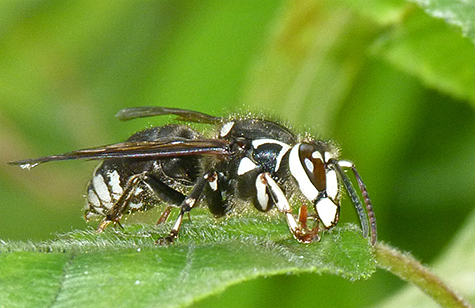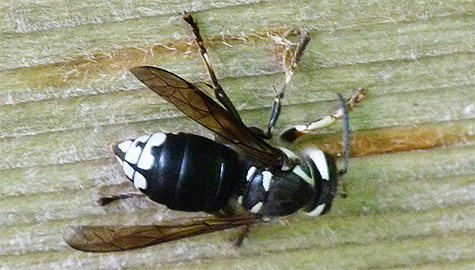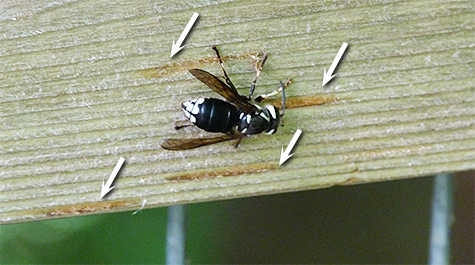
What is the insect in the photo up to? First, let’s establish what the insect is. You may have guessed by its shape that it’s a wasp. You’d be correct. It’s a bald-faced hornet, named for the white (bald) face.

Bald-faced hornets have a reputation, good or bad, for vigorously protecting their hives from intruders. They will activity pursue, en masse, perceived destroyers of their hives. Like the familiar yellowjackets, which is what these wasps actually are, a type of yellowjacket, they will chase after anyone or anything that disturbs their nest.
Bald-faced hornets build those free-hanging, large, gray, oblong hives in trees or shrubs that most people have seen at one time or another. Just seeing one those hives strikes fear into the hearts of many and is usually grounds for removal of the hive due to the creature’s reputation for stinging. If a bald-faced hornet’s hive is spotted anywhere near a human dwelling or where people gather, it’s a safe bet it will be removed.
As you may or may not have reasoned, it’s the hive that’s at the center of the answer to the question above, “what is this insect doing?” It’s gathering material for a hive. The hornet is on the railing of the boardwalk here at the Museum and is chewing off a layer of wood.
Under the old gray-green weathered wood, the wood becomes red-brown in color. Look carefully below. Directly in front of the wasp is fresh wood were the insect has chewed off the weathered layer. The wasp slowly moves backward chewing off wood as it goes.


The wasps collect cellulose, chewing and mixing it with their saliva making a paper substance used to construct a hive. Their hives are made of paper, homemade paper. The wasps add to the hive as its population increases over time to perhaps 100 to 400 workers. The hive may reach a size of 24″ high and 18″ wide.
Despite the hornet’s reputation, eastern yellowjackets, the smaller black and yellow wasp that everyone is familiar with is much more of a pest than the bald-faced. Yellowjackets, who by the way tend to build hives underground or within some sort of structure, visit picnic areas and trash receptacles in search of food for their hives. It’s often here that people run into these wasps, who are certainly not shy about stinging anyone who gets in their way.
And, since yellowjackets often build their hives underground, mowing a lawn where yellowjackets have decided to build can sometimes get homeowners into trouble with the little devils. I have personally been chased around the yard by a group of irate yellowjackets who built a nest in a chipmunk hole smack in the center of my lawn. They don’t give up the chase easily!
So, the next time you see a wasp on the side of a house, deck railing, or even on a twig of a tree with its head to the siding, railing or twig, and it seems to be slowly backing up, you’ll know what it’s doing, making paper for its hive.